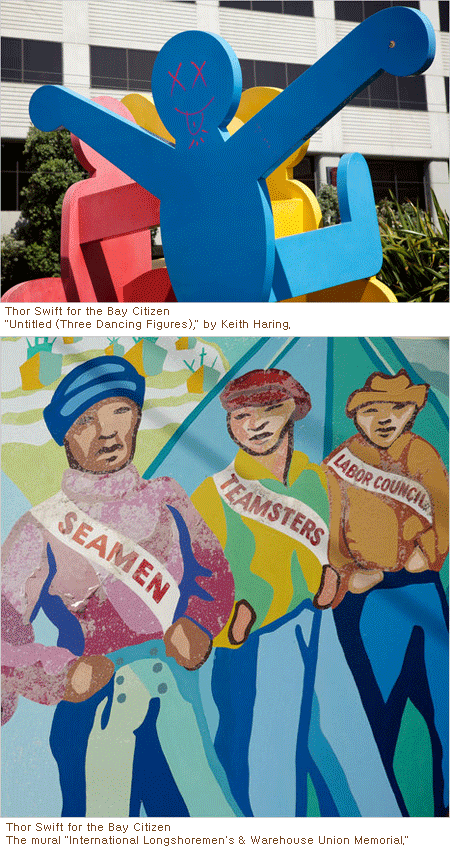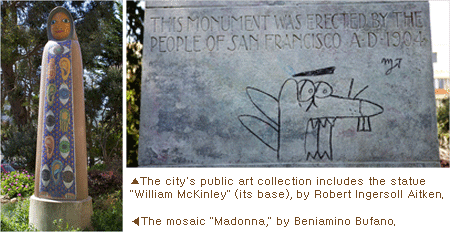The Bay Citizen
City’s Art Is a Victim of Neglect, Damage and LossSan Francisco has a trove of public art that should be the toast of the town. Valued at around $90 million and including more than 4,000 items, including statues, paintings and Edvard Munch lithographs, the Civic Art Collection is one of the richest repositories of city-owned art in the country.

But management of the collection ? which many local residents would be surprised to know even exists ? is so slipshod that the city cannot say for sure how many pieces it owns. Some pieces have been damaged because of lack of maintenance or moth-ridden storage spaces; others have disappeared entirely.
The San Francisco Arts Commission, the city agency responsible for the collection, is especially poor at tracking its unusually large collection of around 2,500 portable works ? paintings and other pieces that are supposed to decorate public spaces and buildings.
In one case, the city acquired 496 art objects for San Francisco General Hospital when it was renovated in 1972. By 2007, a floor-by-floor inspection turned up only 49 works ? 10 percent of what was supposed to be there. Subsequently, more works have been discovered, but the city has yet to confirm the location of 141 pieces.
A big chunk of the city’s Modernist jewelry collection is also missing. A 2008 survey showed that of the 58 pieces in the collection, 19 were lost.
Since the Civic Arts Collection’s inception in 1932, a full survey of the city’s holdings has never been done. A complete inventory, encompassing sculptures and monuments and other stationary works in addition to the portable collection, is under way, but until its scheduled completion in late 2012, the city can only guess at the collection’s size.
Allison Cummings, senior registrar for the collection, began work on the inventory in 2009. She estimates the total number of works at 4,094 (including duplicates and large pieces comprising several smaller pieces).
Nearly one-quarter of the collection, an estimated 905 pieces, is in storage, while the rest is scattered around parks, hospitals, offices, courtrooms and other public city-owned spaces.
When asked about the number of pieces that could be damaged or missing, Luis Cancel, director of cultural affairs for the arts commission, said, “It is impossible for us to estimate or even comment on an inventory process that is presently ongoing.”
Upon request by The Bay Citizen, the city sent a partial list of its inventory, with 2,673 items of stationary and portable works. Many of the fields, like “dimension,” were unfilled, and question marks were sprinkled throughout. “The PDF files are the most complete record we can provide at this time,” said Kate Patterson, public relations manager for the arts commission.
The commission declined to provide locations for the items listed in the portable collection, citing security concerns.
Public and private arts institutions struggle with collection management, but throughout its history, San Francisco has allocated few resources to caring for its art
The job of collections manager (now called senior registrar) was not created until the 1980s; before that, no one person was in charge. The position was vacant from 2004 to 2007, when Ms. Cummings, a veteran of the San Francisco Museum of Modern Art and other museums, was hired. She found that the city’s records “weren’t in as good a shape as they should have been.”
Now the Civic Art Collection’s care falls to three people: a full-time registrar, a part-time registrar and a project manager.
By contrast, Seattle, whose city art collection also contains thousands of portable works, has five full-time and four part-time employees in charge of public art. It also maintains an active database of its collection and does a complete inventory every four years, according to Ruri Yampolsky, director of the public art program for the Office of Arts and Cultural Affairs in Seattle.
“We’re really careful to make sure we know where everything is,” Ms. Yampolsky said.
San Francisco’s large portable collection is mostly a remnant of the city’s art fairs from 1946 to 1986, which were held to support local artists. As a result of these offbeat fairs and other purchases, a catalog of the collection’s portable items reads like the packing list of an eccentric millionaire: world-class paintings by Wayne Thiebaud and Richard Diebenkorn are listed alongside jewelry, ceramic bowls and bolts of fabric. There’s even textile art ? a wool skirt and a white leather jacket.
Now art is acquired through the Art Enrichment Ordinance. Enacted in 1969, it mandated that 2 percent of civic construction costs go toward acquiring public art. Because city finance laws do not allow bonds to finance maintenance, however, very little goes to the collection’s care.
A scant $15,750 a year, from the arts commission’s annual $11 million budget, is marked for physical upkeep of the collection. By contrast, Seattle finances collection upkeep with $187,000, which includes a conservator’s salary.

A private fund-raising effort, ArtCare, was set up in 2010 to beef up preservation in San Francisco, but it focuses on large stationary pieces, not portable works. An analysis of minutes from meetings going back to 2003 of the Visual Arts Committee and the Executive Committee, two governing bodies of the San Francisco Arts Commission, showed that arts officials had been concerned about the collection for years.
In 2007, Jeannene Przyblyski, then chairwoman of the Visual Arts Committee, suggested that the cataloging troubles showed “why the city is not the best repository for art collections.”
In minutes from 2008, Mr. Cancel, the arts commission director, “lamented that the collection is not being cared for under museum standards, as it should be for the long term, because of inadequate resources.”
Compounding the difficulties inherent in keeping tabs on such a sprawling collection is the department’s loan program.
Although the number is always in flux, the commission estimates that 1,057 portable works are now decorating city offices and other public spaces. Departments pay a fee and art is installed with security mounts, but the art is examined only when the two-year loan expires or when someone alerts the arts staff that something has been moved.
Ms. Cummings and Jill Manton, director of programs, acknowledged the security risk.
“In the ideal world, we’d either have sufficient staff to be going out on at least an annual basis checking on everything,” Ms. Manton said.
Past members of the Visual Arts Committee said that the collection had problems but also pointed to inadequate resources.
“You have to make horrid choices. Do you pay to reframe all the 2-D work in the Civic Art Collection, or do you make sure there’s arts education in schools?” said Ms. Przyblyski, now the vice president and dean of academic affairs at the San Francisco Art Institute.
As fiscal woes continue for San Francisco, recourse for the public’s treasure is limited. But if San Francisco’s art is not counted, cared for or displayed, it raises the issue of whether the city should continue to hold its collection.
It’s a quandary facing many cities looking to slash budgets.
“That’s the $100,000 question,” said Abby Suckle, president of CultureNOW, a national public art mapping project based in New York, who has been working with cities to create more awareness about public art.
“It’s one thing to make it,” Ms. Suckle said, referring to a city art collection. “But if you don’t take care of it, what good is it?”

